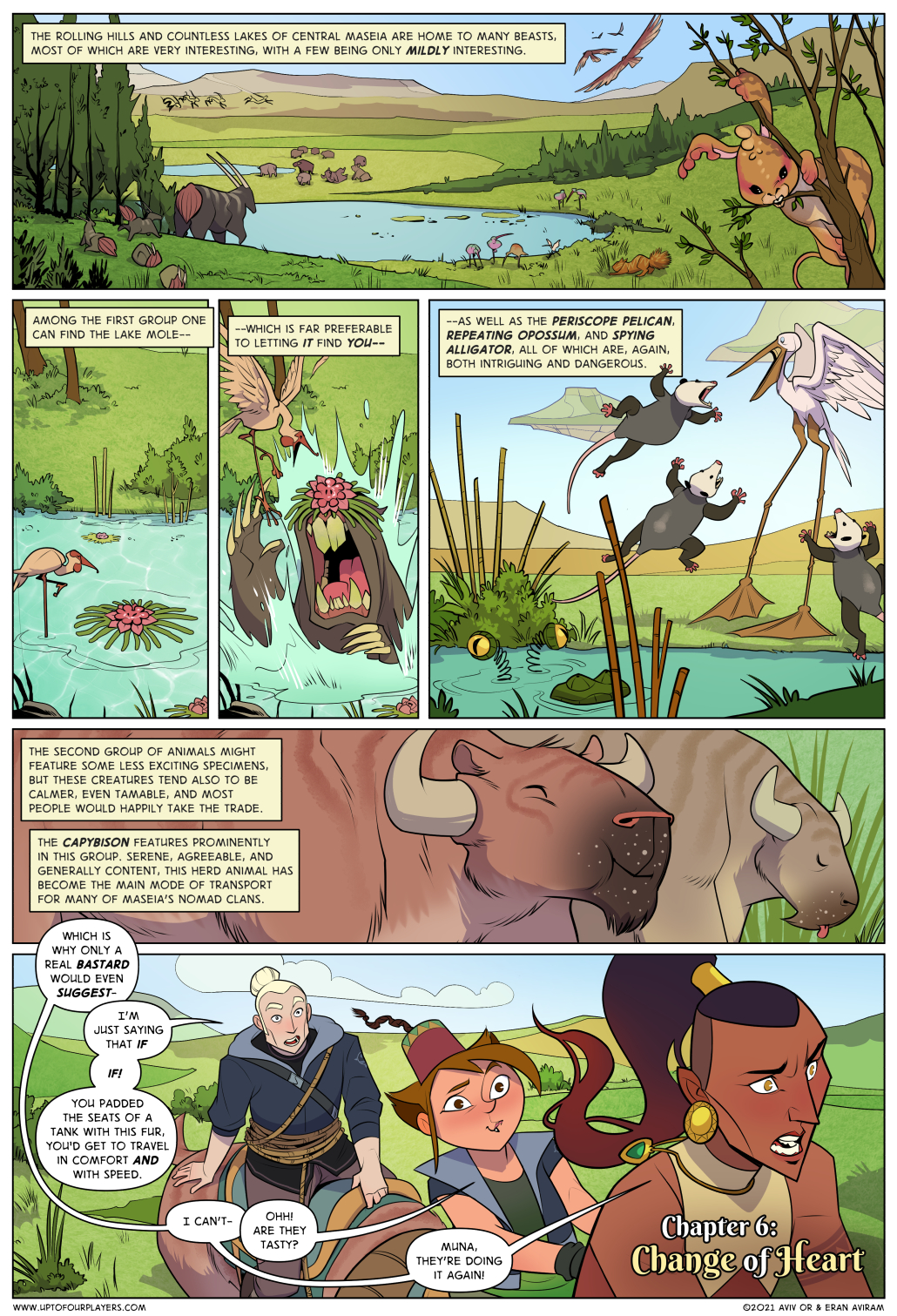Welcome to this, our sixth chapter!
Before you ask “do you have stats for all of these creatures?!” let us pre-answer: yes.
A capybison uses the statistics of a bull (SWADE 180).
A spying alligator is an alligator (SWADE 180) with two extra “eyes”, basically just antennas on spring-like cartilage, so it seems like it’s always alert and looking. But it’s actually facing the other way around, the “eyes” are on its butt. Instead of a long, powerful tail, it has a snubbed butt, that looks like the front of an alligator. In rules, its aquatic pace is 4 (no strong tail) but it gets a special +2 on Stealth rolls.
A periscope pelican isn’t combative, so it’s best to use it as a hazard. It’s enough for a small family, 5-6, to create a huge mess – they love walking around, as tall as a person, with long and quick steps, filling up the space around you with noise and flapping wings. They’re not afraid of people; in fact, like real-world pelican, many have learned that humans give food, and so they annoy groups of people until being given lots of fish. If frightened they scatter, but they’re really quick on those legs, and regroup after a few moments. They can only fly short distances.
A repeating opossum is considered by some to be a convergent evolution along the lines of the bolf (Crystal Heart 173). A tri-possum is actually just one-possum, which can become three for a very limited time, about a turn. They’re fierce, opportunistic hunters. Use the statistics for small cat (SWADE 181), but size -2, and it can duplicate itself in order to make up to three actions without a multi-action penalty; they must be the same type of action, repeated three times. It can use this ability once; if pressed, it can do so again but must make a Vigor roll or take a level of fatigue.
The lake mole already appears in our book (Crystal Heart 177), copied here for your pleasure:
The lake mole is a carnivorous rodent the size of a large dog. Besides its unusual size, the mole is mostly known for the thin tendril-like organ that emerges from its nose, which it can puff up to create a round, green circle. The mole hunts by submerging itself in the shallow water close to a lake’s bank, where its nose organ looks almost indistinguishable from the average lily pad. Its diet consists of small birds, frogs, roots, and the occasional fish.
The lake mole is nearly blind, but it’s highly sensitive to vibrations, both underground and underwater. The mole is especially active during spring time, when hundreds of them travel underground between neighboring lakes in search of mates. That’s the best time of the year to hunt them down—their fur is highly praised for its water resistant properties.
Attributes: Agility d6, Smarts d4(A), Spirit d8, Strength d8, Vigor d8
Skills: Athletics d8, Fighting d8, Notice d8, Stealth d10
Pace: 8; Parry: 6; Toughness: 6 (1)
Edges: —
Special Abilities
• Armor +1: The lake mole’s hide and fur are quite thick.
• Blind: If the lake mole can’t touch the ground or a body of water, it’s effectively blind.
• Burrow (8”): The lake mole can easily move its Pace through soft ground, digging about 3 feet underneath the surface. It can just as easily submerge itself underwater.
• Camouflage: When lying still in its native ambush environment (among lily pads and between reeds), the mole gains +4 to Stealth rolls.
• Claws: Str+d6.
• Size -1: About as big as a big dog
The grasping bunny in the first image didn’t appear in the script, so it’s Aviv’s problem.




